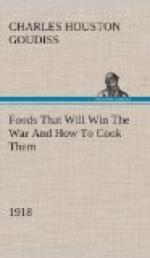Our grandmothers knew how to prepare many dishes without sugar. In their day lack of transportation facilities, of refining methods and various economic factors made molasses, sorghum, honey, etc., the only common methods of sweetening. But the housekeeper of to-day knows little of sweetening mediums except sugar, and sugar shortage is to her a crucial problem. There are many ways, however, of getting around sugar shortage and many methods of supplying the necessary food value and sweetening.
By the use of marmalades, jams and jellies canned during the season when the sugar supply was less limited, necessity for the use of sugar can be vastly reduced. By the addition to desserts and cereals of dried fruits, raisins, dates, prunes and figs, which contain large amounts of natural sugar, the sugar consumption can be greatly lessened. By utilizing leftover syrup from canned or preserved fruits for sweetening other fruits, and by the use of honey, molasses, maple sugar, maple syrup and corn syrup, large quantities of sugar may be saved. The substitution of sweetened condensed milk for dairy milk in tea, coffee and cocoa—in fact, in all our cooking processes where milk is required—will also immeasurably aid in sugar conservation. The substitutes mentioned are all available in large amounts. Honey is especially valuable for children, as it consists of the more simple sugars which are less irritating than cane sugar, and there is no danger of acid stomach from the amounts generally consumed.
As desserts are the chief factor in the use of quantities of sugar in our diet, the appended recipes will be of value, as they deal with varied forms of nutritious, attractive sugarless desserts. It is only by the one-ounce savings of each individual member of our great one hundred million population that the world sugar shortage may be met, and it is hoped every housekeeper will study her own time-tested recipes with the view of utilizing as far as possible other forms of sweetening. In most recipes the liquid should be slightly reduced in amount and about one-fifth more of the substitute should be used than the amount of sugar called for.
With a few tests along this line one will be surprised how readily the substitution may be made. If all sweetening agents become scarce, desserts can well be abandoned. Served at the end of a full meal, desserts are excess food except in the diet of children, where they should form a component part of the meal.
[Illustration]
SUGARLESS DESSERTS
CRUMB SPICE PUDDING
1 cup dry bread crumbs
1 pint hot milk
Let stand until milk is absorbed.
1/4 teaspoon salt 1/2 cup molasses 1/4 teaspoon cinnamon 1 egg 1/2 teaspoon mixed spices, cloves, nutmeg, allspice, mace and ginger 2/3 cup raisins, dates and prunes (steamed 5 minutes)
Mix and bake 45 minutes.




